|
|
File
"Eno Bellis" Civic Archaeological Museum – Oderzo
|
Via Garibaldi 63 – 31046 Oderzo (TV)
– Fax 0422 713333 |
  |
|
Summary
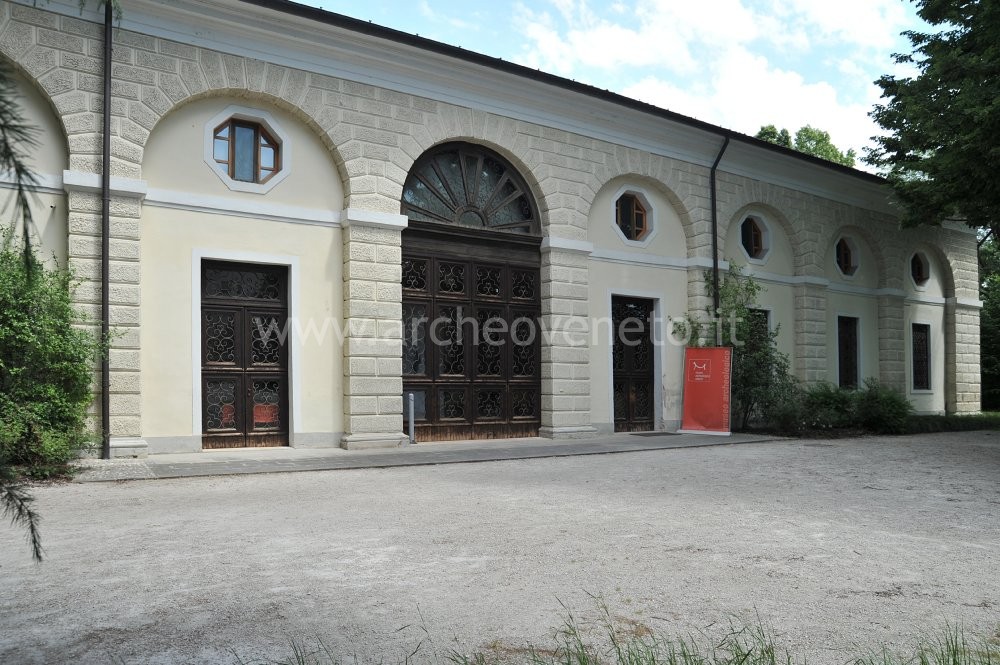
The Civic Archaeological Museum of Oderzo, founded in 1876 and moved to the "Barchessa" (rural building of a Venetian villa) of Palazzo Foscolo in 1999, is named after Eno Bellis, who was honorary inspector for the cultural heritage and director of the museum for more than a decade. The collection gathers the most significant archaeological finds discovered in Oderzo both in the 19th century by local families and more recently, over the last twenty years, during the excavations carried out by the regional board of the Ministry of Cultural Heritage and Environmental Conservation in charge of archaeology. The visit, which starts on the upper floor, follows a chronological path and is divided into two sections: a Pre-Roman and Roman section.
Collection history
The “Eno Bellis” Museum was founded in 1876 following the numerous findings in the territory of Oderzo around the mid 19th century.
Besides these findings, the collection boasts important donations spontaneously made by local citizens who had been invited to personally contribute to the growth of the museum assets in 1879. The last donation made by citizens dates back to 1953. All items found afterwards are state-owned and under the direct competence of the regional board of the Ministry of Cultural Heritage and Environmental Conservation in charge of archaeology. From 1957 to 1999 the museum was hosted in a small building near the Town Hall of Oderzo. In 1999 the collection was moved to the Barchessa of Foscolo Palace, a majestic building in the heart of a huge park.
|

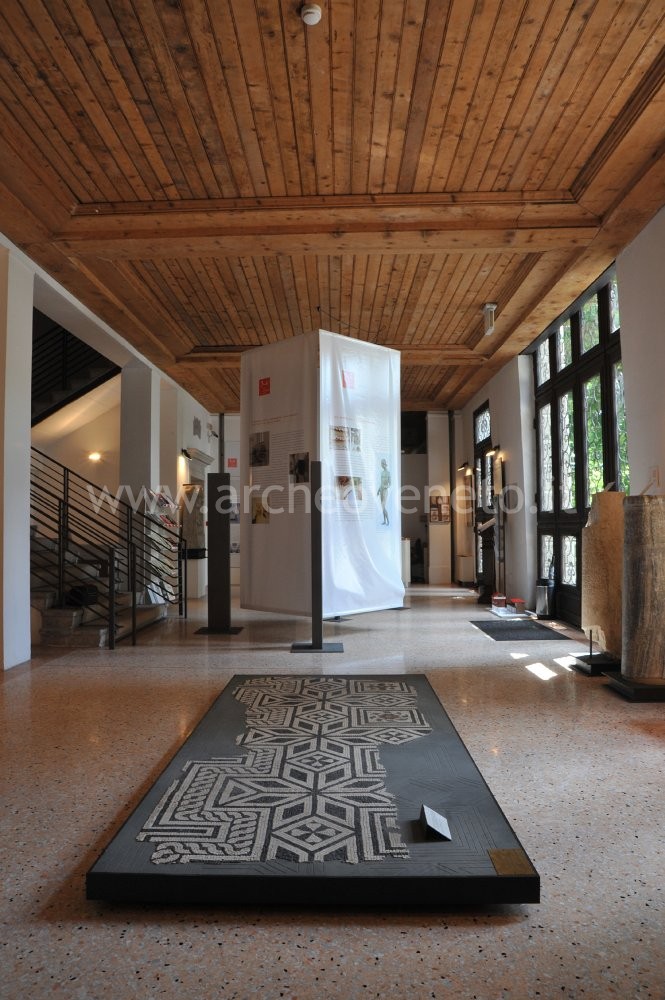 At the entrance there is a funerary stele in the form of an aedicule from the 1st century AD, discovered in 2000 during excavation works carried out in the town of Oderzo. There are two small crouched lions on the gable and on the back of the niche, which has the form of a half shell. It also features three portraits depicting two female figures and a male one, one of which depicts the deceased Phoebe, whose name is engraved on the base of the stele. At the entrance there is a funerary stele in the form of an aedicule from the 1st century AD, discovered in 2000 during excavation works carried out in the town of Oderzo. There are two small crouched lions on the gable and on the back of the niche, which has the form of a half shell. It also features three portraits depicting two female figures and a male one, one of which depicts the deceased Phoebe, whose name is engraved on the base of the stele.
At the entrance, near the cloakroom, there are other stone elements, among which a squared marble tablet with the head of Jupiter Ammon, originally used to decorate the structure of the forum area and four milestones from the Imperial age from the via Postumia, the road Opitergium-Tridentum and the via Annia.
Along the stairs which lead to the Pre-historic and Proto-historic sections there is a dichromatic geometric mosaic found in via S. Martino (early 2nd century AD).
|

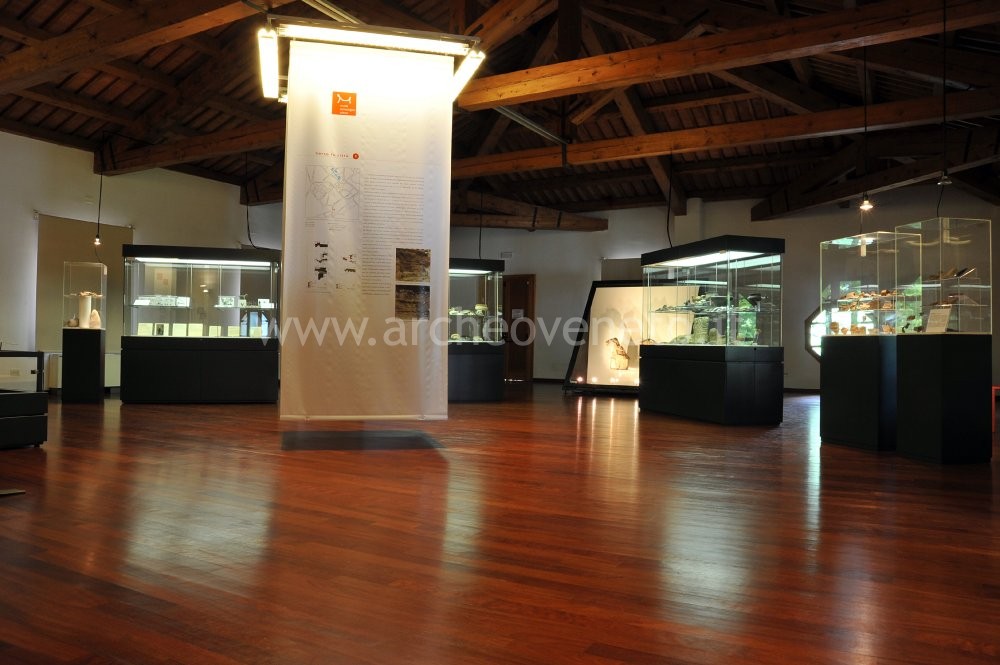 The visit to the museum starts on the first floor with the exhibition of Pre-historic and Proto-historic objects found in Oderzo and its surrounding area. It is well know that the area around Oderzo was already inhabited in the Neolithic Age but only later, during the Middle and Recent Bronze Age, also the current city centre was occupied. The visit to the museum starts on the first floor with the exhibition of Pre-historic and Proto-historic objects found in Oderzo and its surrounding area. It is well know that the area around Oderzo was already inhabited in the Neolithic Age but only later, during the Middle and Recent Bronze Age, also the current city centre was occupied.
Display case no. 1 houses archaeological finds from the Pre-historic period and the early phase of the Iron Age found in the area around Oderzo.
Display case no. 2 exhibits pottery from excavations carried out in via Dalmazia, via Roma, piazzale Europa and piazza Vittorio Emanuele II. Archaeological finds from the Proto-historic village, founded around the 10th-9th century BC were discovered during recent excavations carried out in via Savonarola and via dei Mosaici, areas devoted to artisanal activities (working with clay and building material).
All the objects displayed in display case no.3 were collected in via Savonarola and bear witness to the steady presence of people during the 1st millennium BC. In the same display case, objects discovered during occasional surveys and the so-called “struttura 14” in via Savonarola are exhibited.
The two ornamental elements in the form of animals from 6th-5th century BC found in via Savonarola are displayed in display case no. 4.
Starting from the 6th century BC on, the settlement underwent a strong development, as witnessed by the two large buildings found near S. Martino and via delle Grazie. The plan of this multifunctional buildings, with an area destined to residential purposes and one to handicraft activities, was marked by the presence of a central courtyard; its building technique betrays the strong attachment to local traditions. Display case no. 5 contains objects from these areas, via dei Mosaici and via Mazzini.
The ancient necropolis was situated on the periphery of the settlement, in the current via Garibaldi. Two tombs (6th century BC), a male inhumation tomb and a female cremation one, come from this area. Their respective grave goods are displayed in display case no. 6, which also contains numerous votive bronze statuettes from the 5th-2nd century BC, depicting warriors under attack, a horse and a cloaked man (figure with specific sacerdotal duties), miniature models of spears and shields, the handle of a simpulum and votive tablets with decorations and engravings. An outstanding selection of fibulae is also shown in this display case.
The last section of the room is dedicated to Venetic inscriptions made out of ceramic, bone and stone.
|

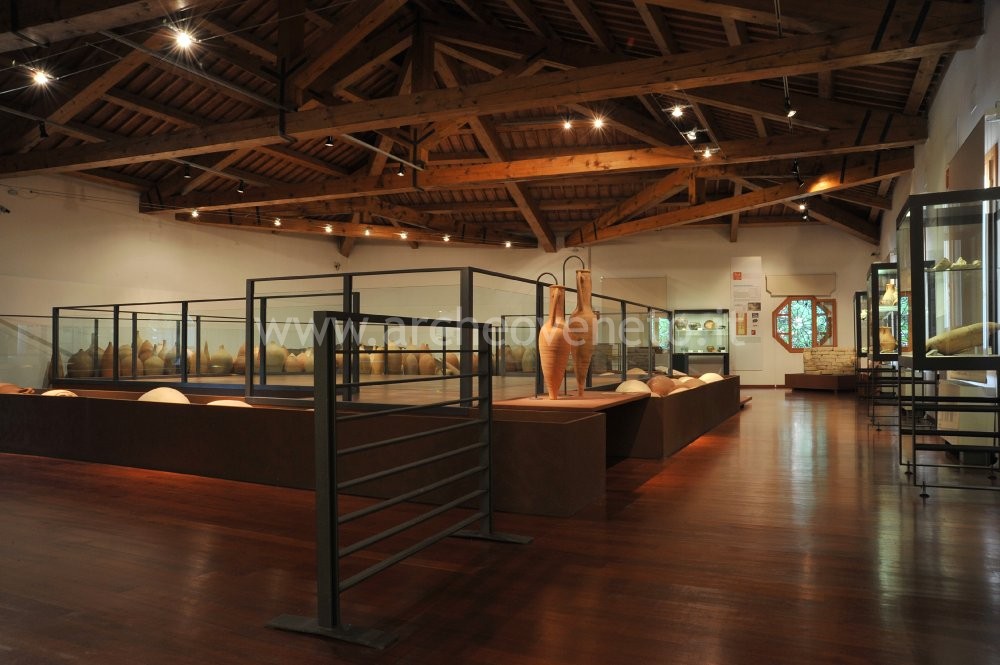 Panels providing information related to the Roman town are placed along the aisle which leads to the amphorae section. Panels providing information related to the Roman town are placed along the aisle which leads to the amphorae section.
The first floor of the museum also houses the Roman section dedicated to the large number of amphorae (around 1000 items) found during the excavations carried out in Oderzo. The replica of four types of drainage used in Oderzo was set up in order to show the secondary function of these vessels. The visit ends with a typological exhibition of the amphorae from Oderzo dating back to the 2nd/1st century BC – 4th/7th century AD.
|

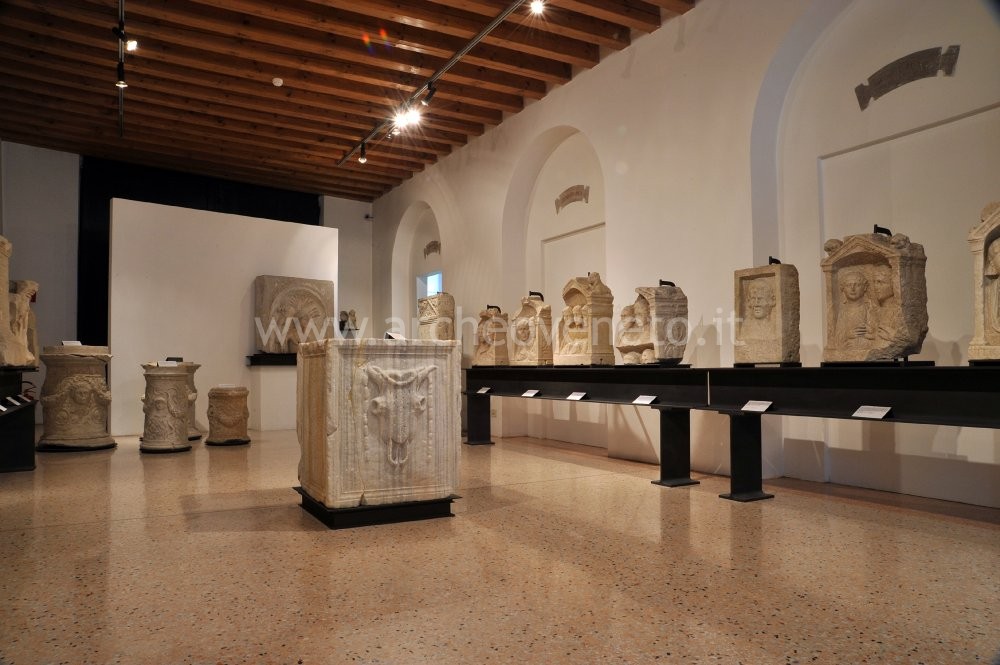 On the sidewalls of the large room situated on the ground floor there are several burial monuments from the Roman Age found in three burial sites in Oderzo. On the right, there are ten funerary steles (1st century AD), in the form of aedicula and pseudoaedicula, with the busts of the deceased depicted inside the steles; on the left, there are steles with Latin inscriptions, funerary altars, cinerary urns and covering bowls. In the middle of the room there are a squared funerary urn made out of limestone from Aurisina and decorated with two maenads and kantharos from Motta di Villanova (mid 2nd century AD), a portion of a limestone monument with curvilinear lines decorated only on one side (2nd century AD) and a fragment of a votive marble altar, with side panels decorated with brucanium and patera. On the sidewalls of the large room situated on the ground floor there are several burial monuments from the Roman Age found in three burial sites in Oderzo. On the right, there are ten funerary steles (1st century AD), in the form of aedicula and pseudoaedicula, with the busts of the deceased depicted inside the steles; on the left, there are steles with Latin inscriptions, funerary altars, cinerary urns and covering bowls. In the middle of the room there are a squared funerary urn made out of limestone from Aurisina and decorated with two maenads and kantharos from Motta di Villanova (mid 2nd century AD), a portion of a limestone monument with curvilinear lines decorated only on one side (2nd century AD) and a fragment of a votive marble altar, with side panels decorated with brucanium and patera.
At the end of the room there are four cylindrical altars from 1st century AD; next to them, there are a relief depicting the Summer in the form of a living figure (first half of 1st century AD) and an acroterion of a funerary stele in the form of a winged sphinx (early 1st century AD).
|

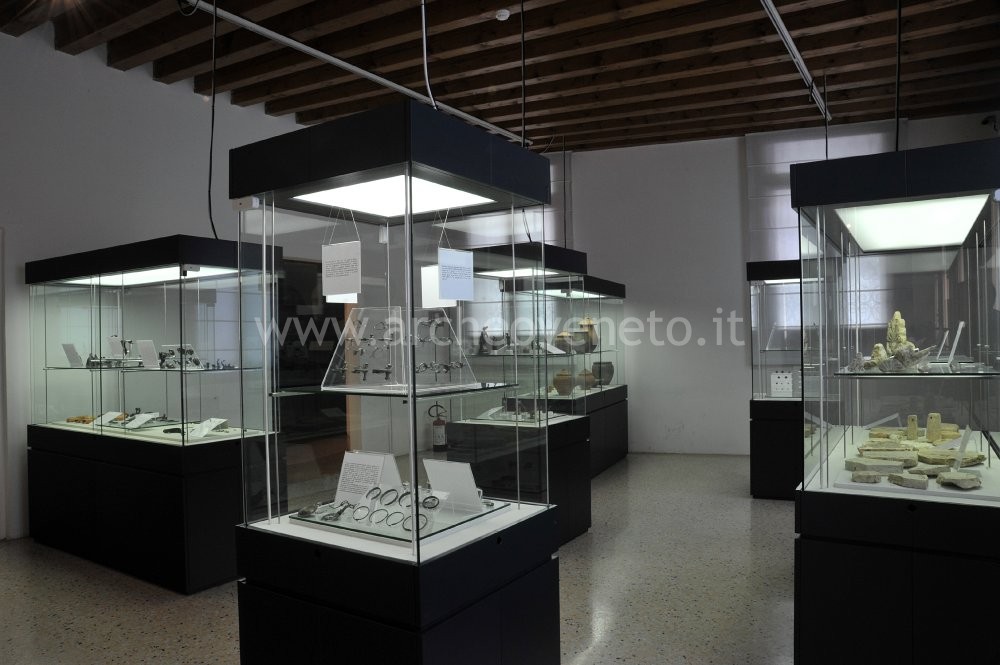 This room on the ground floor houses Roman objects from different collections or found by chance. It hosts six display cases with objects related to daily life and funeral rituals from the Roman Age, ordered thematically. This room on the ground floor houses Roman objects from different collections or found by chance. It hosts six display cases with objects related to daily life and funeral rituals from the Roman Age, ordered thematically.
The display case no. 1 exhibits burial items: a grave good from a grave in Lutrano (late 1st century BC-early 1st century AD), two cremation burials from S. Anastastio, different examples of ceramic ossuary, miniature ollas and blown-glass unguentarium from different sites.
The display case no. 2 contains several specimens of coins found in the area of Oderzo. The small numismatic collection dates back to a broad time span ranging from 3rd century BC to the 7th century AD.
The display case no. 3 focuses on building material from the Roman Age, thanks to a selection of stamped tiles and fragments of wall plasters.
The display case in the middle of the room houses a rich collection of bronze statuettes depicting various Roman deities and animals.
The display case on the right contains a significant selection of Roman domestic objects, while the last one houses an interesting selection of personal accessories.
Finally, on the wall there are seven marble and lime heads, dating back to 1st century BC and 3rd century AD, from Oderzo, Settimo di Portobuffolè and Meduna di Livenza.
|

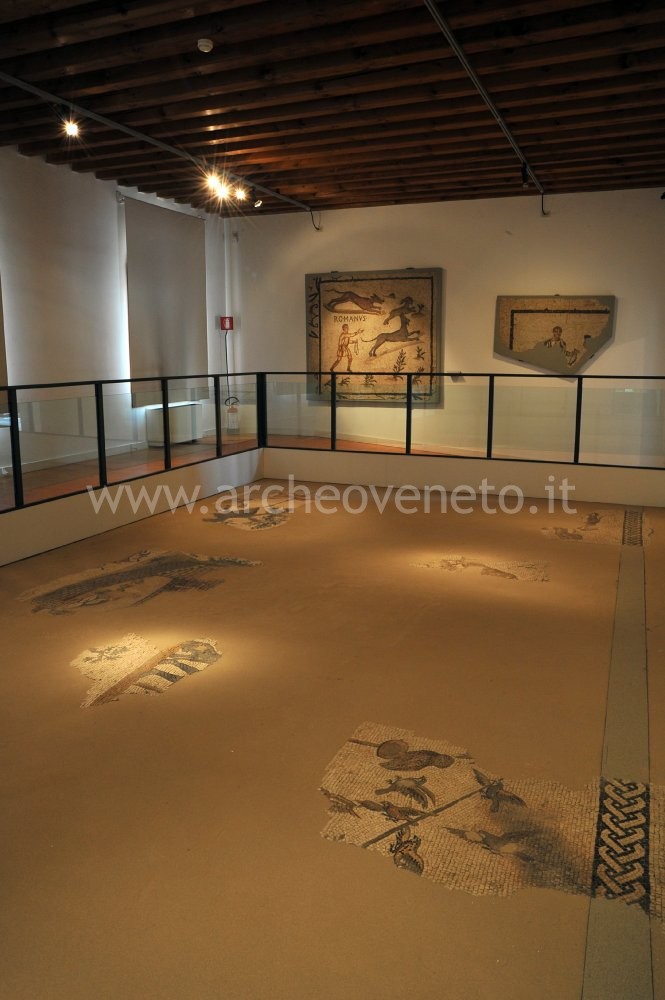 The last room on the ground floor is occupied by three fragments of mosaics from Late Antiquity found in Oderzo (late 3rd-early 4th century AD). The last room on the ground floor is occupied by three fragments of mosaics from Late Antiquity found in Oderzo (late 3rd-early 4th century AD).
The eight fragments of mosaic lying on the floor belong to the great “Mosaico della Caccia” (mosaic on hunting), discovered in 1891 in the former vegetable garden “Gasparinetti”. It is articulated in three registers and depicts different scenes and aspects of rural life: country villa, hare hunting, sheep grazing, wild bird hunting with lime and owl and wild boar hunting.
The two polychromous mosaics aligned along the wall come from piazzale della Vittoria and depict a scene with a cupbearer pouring wine and a scene of hare hunting with dogs respectively.
|
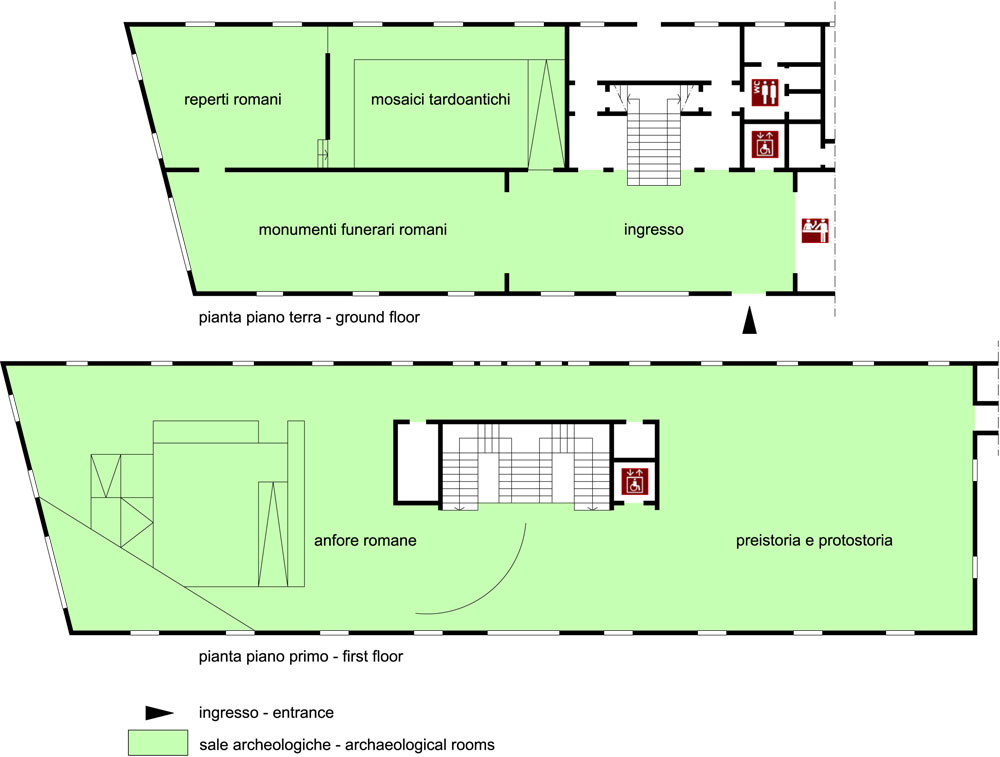
Admission: Negli orari di apertura
Ticket: Si
Price: Full fare 3 €; Reduced fare (children aged between 14-18, seniors 65+), groups of 10 or more people 2€; Students 1 €; Tour guides, Teachers, Disabled person and Carer: free; Joint ticket (museum + picture gallery) 4 €; 3 € reduced fare.
 School access School access
 Disabled access Disabled access
Opening Days
| Tipology |
When |
Specs |
| Summer |
Wednesday |
9.00 – 12.00 e 14.30 – 18.00 |
| Summer |
Thursday |
9.00 – 12.00 e 14.30 – 18.00 |
| Summer |
Friday |
9.00 – 12.00 e 14.30 – 18.00 |
| Summer |
Saturday |
9.00 – 12.00 e 14.30 – 18.00 |
| Summer |
Sunday |
16.00 – 19.00 |
| Winter |
Wednesday |
9.00 – 12.00 e 14.30 – 18.00 |
| Winter |
Thursday |
9.00 – 12.00 e 14.30 – 18.00 |
| Winter |
Friday |
9.00 – 12.00 e 14.30 – 18.00 |
| Winter |
Saturday |
9.00 – 12.00 e 14.30 – 18.00 |
| Winter |
Sunday |
15.00 – 18.00 |
Closed on the 1 and 16 January, Easter Sunday, 1 May, 15 August, 25-26 December
Recommended tour time (minutes): 60
 Toilet Toilet
 Bookshop Bookshop
 Rest points Rest points
 Guide a stampa Guide a stampa
Brochure
Italian, English
 Information boards Information boards
Italian
 Captions under exhibits Captions under exhibits
Italian
 Multilingual ads: Inglese Multilingual ads: Inglese
Brochure
 Guided Tours Guided Tours
 Educational activities Educational activities
 Educational workshops Educational workshops
 Library and documentation centre Library and documentation centre
 Other activities Other activities
| Forlati Tamaro B. 1958, Guida al Museo Civico di Oderzo, Milano. |
| Mantovani G. 1974, Museo Opitergino, Bergamo. |
| Forlati Tamaro B. 1976, Iscrizioni lapidarie latine del Museo Civico di Oderzo, Treviso . |
| Sculture e mosaici romani del Museo Civico di Oderzo 1976, Treviso. |
| Sandrini G.M. 1995, Il riallestimento del Museo Civico Opitergino “Eno Bellis” di Oderzo, in Quaderni di Archeologia del Veneto, XI, pp. 228-230. |
| Il Museo Civico Archeologico “Eno Bellis” 2000, a cura di Possenti E. , Ponte di Piave . |
| Possenti E. 2000, Il nuovo Museo Archeologico “Eno Bellis” di Oderzo , in Quaderni di Archeologia del Veneto, XVI, pp. 197-200. |
| Tirelli M. 2003, Itinerari archeologici di Oderzo, Treviso . |
| Musei e raccolte archeologiche del Veneto 2004, a cura di Di Mauro A., Dosson di Casier, pp. 90-91. |
| Bonetto J. 2009, Veneto (Archeologia delle Regioni d’Italia), Roma, pp. 418-421. |
|

